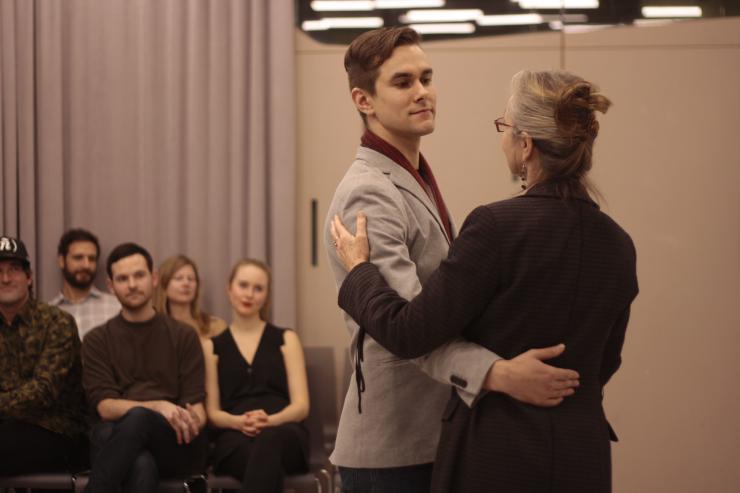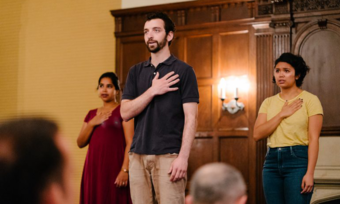The Fifth Wall
Climate Change Dramaturgy
This week on HowlRound, we continue our exploration of Theatre in the Age of Climate Change begun a year ago in honor of Earth Week 2016. How does our work reflect on, and respond to, the challenges brought on by a warming climate? How can we participate in the global conversation about what the future should look like, and do so in a way that is both inspiring and artistically rewarding? NYU professor Una Chaudhuri is one of the great thinkers on eco-theatre. I met her only a year ago but her warmth and generosity make me feel like I have known her for a long time. Her ideas constantly help shape my own. —Chantal Bilodeau

In Finale, by Kendra Fanconi, a single actor on stage addresses an audience member. “Friend,” the actor says, and asks that person if they can hold hands:
Okay, it’s a little freaky maybe and I have sweaty palms. But we are friends and we have opposable thumbs so I just thought. I mean, we are not the only one in the world with opposable thumbs. You should see the raccoons get into my compost. But you and I have this thing we can do with our hands that no other mammals can—that is the way our hands fold and our fingers do this. (Touches fingers to bottom of palm.) It means we can hold things tightly. It’s a defining characteristic of our species. It’s this powerful thing we can do. Can I take your hand? Will you hold mine?
They do, of course, and they even wind up slow dancing together, sharing a physical and social closeness that communicates itself powerfully to the onlookers.
It’s no surprise that reaching across the fourth wall is one of the ways contemporary theatre is engaging with the ecological crisis. After all, forging intimate bonds between actors and spectators has been a powerful part of political theatre for the past half century, formalized in genres like the happening, environmental theatre, and—more recently—immersive performance like the wildly successful Sleep No More. As such, it has a lot to offer to theatre engaged in the project of ecological consciousness-raising. Fanconi’s actor ends the play by stating, in the simplest possible terms, a new destiny for the theatre of co-presence in the age of climate change:
…fellow-human-who-can-hold-things-tightly […] don’t say a word. Just know that I am here, okay? When it feels very large and very daunting remember that. This is something we are doing together. Spinning around the sun. Very slowly. On the one planet we have. That the ones like us, who can hold things tightly, must save.

Many of the plays that emerged in response to the recent Climate Change Theatre Action project used forms of direct address to capture the range of feelings this subject arouses: urgency, fear, despair, rueful resignation, even savage mockery. Thus Darrah Cloud’s TESS Talk parodied the smug talk of the expert lecture circuit by giving its audience step-by-step instructions on “How to Deny Climate Change”:
Step 2: Join PEHA, People for the Ethical Hating of Animals. Let’s face it, guys. Animals are stupid. They can’t talk, they don’t wear clothes, they certainly don’t contribute to the economy by buying anything. They’re all victims of the developing world and we hate victims. Victims ask for it. They like being victims. They’re weak and ignorant and can’t even hire a good lawyer. And they smell. If your grandkids complain, take away their teddy bears and replace them with real taxidermy so they know what it is they’re whining about. That’ll stop ‘em! Hah!
Theatre addressing climate change is making use of the representational strategies and modes of address developed over the past half century. But it’s also inventing new strategies that will align the theatrical apparatus with the altered conceptual frameworks offered—or necessitated—by climate change.
These are just two of the many instances in which theatre addressing climate change is making powerful use of the representational strategies and modes of address developed over the past half century. But it’s doing something else as well: inventing new strategies that will align the theatrical apparatus—its conventions, protocols, and possibilities—with the altered conceptual frameworks offered—or necessitated—by climate change. My shorthand term for this new set of inventions is “Fifth Wall Dramaturgy.” Explaining it involves sketching in certain theoretical considerations, in particular about what else changes as the climate does.
Climate change, we’re realizing, goes way beyond climate. The changes coming—or already happening—affect every level of human activity and experience, including fundamental things like where we (can or cannot) live, what’s left for us to eat safely, and how we’ll think and what we’ll say about our species in light of our unplanned world-changing effects on this planet. Recognizing for the first time that we humans are a geophysical force—that our activities shape and hence are part of geophysical and ecological systems—forces us to expand the frames of our self-understanding. The fact that our current and recent lifeways have inadvertently affected such massive entities as the ocean (acidification, rising sea levels, etc.) and the polar ice caps (glaciers melting, ice sheets breaking up) tells us that our usual frames of self-analysis—mainly, the psychological, sociological, and political—are no longer adequate. We need to redraw the boundaries and expand the frame within which human meaning is created. We need to understand the human in its complex relation to the nonhuman, a relation that is both determining and determined, partly under our control, mostly outside it.
One of the first boundaries that climate change disrupts is also one of the most ideologically powerful conceptual structures of modernity: the boundary that defines a nation. As the United Nation’s Intergovernmental Panel for Climate Change signals in its very name, climate change doesn’t respect national borders. The nation—the master-fiction of the world politics of the past several centuries—is under attack from both economic and ecological directions. Economically, it is utterly undermined by globalization; ecologically, by climate change. The waves of refugees currently crashing on the shores of Europe are figures of both forces, and the incoherent political and moral response to their plight is evidence of how increasingly entangled the skeins of politics, economics, and ecology now are. When this entanglement suddenly produces an image that rivets the attention of the world—for example, the image of little Aylan Kurdi, the three-year old Syrian boy lying dead on a beach in Turkey—we are challenged to align these complex realities with our deepest emotional responses, challenged to balance our sorrow for Aylan with our feeling of helplessness before the forces that brought him to that beach: the devastating droughts that have displaced countless populations, in Syria, Africa, and elsewhere, leading to conflicts which become politicized (and which the media insists on representing as solely political or sectarian, ignoring their ecological dimensions and origins).
The image of Aylan that caught the world’s attention, and the many artworks that image has inspired, open a space for reflection about the new intersection of politics and ecology that climate change is ushering in at great speed. As climate change, sectarian conflict, and globalization increasingly make nonsense of the political power of nations, it is forcing us to reckon with that border that all countries share and that all have always ignored: their border with the atmosphere. Other than occasions when a country’s “air space” is “violated,” or when enemy bombs rain down on us, we rarely think of the sky as a political space. Climate change is challenging that assumption, forcing us to recognize that the ways we’re affecting or interfering with each other’s national spaces is not restricted to modes like trade, diplomacy, and warfare: rather, the carbon emissions of one nation can play an inordinately large role in damaging the ecology of distant places, with the atmosphere, our common border, serving as the major conduit—a “free” space: totally unregulated by the laws of nations, utterly uncontrollable by human beings, completely impervious to our species’ wall-building prowess. To begin to take this space seriously will require us to develop an “atmospheric” consciousness.
Looking up at the sky has been, traditionally and archetypally, a figure for aspiration. On occasion, as when we are exhorted to contemplate the vastness of the universe, it has been a figure for humility, a call to acknowledge the puniness of our humanity. Both moves are sentimental and inflated, whether in self-aggrandizement or self-effacement. The same two kinds of inflation are currently tempting the discourse around climate change. There are those who see in the looming crisis a chance for our species to make paradigm-shifting leaps in technological innovation and scientific mastery. There are others who see it as the twilight of human civilization, a time for mourning and letting go.
Fifth Wall Dramaturgy is an alternative way of ‘looking up.’ It’s an activation of the ‘diegetic’ mode of literary communication—the ‘telling,’ as opposed to the ‘showing,’ or ‘mimetic’ mode.
Fifth Wall Dramaturgy (and the “atmospheric imagination” it reflects) is an alternative way of “looking up.” It’s an activation of the “diegetic” mode of literary communication—the “telling,” as opposed to the “showing,” or “mimetic” mode—that ecologically-prescient modernists had begun to use decades ago to point to the natural world that always silently surrounds the clamorous social interactions on stage. To be sure, in the past that “view beyond the social world” had been fleeting, and decidedly dismal, as in the following moment in Pinter’s The Caretaker:
DAVIES: What’s that? A pond?
ASTON: Yes.
DAVIES: What you got, fish?
ASTON: No. There isn’t anything in there.
Pause
This is a “world” view only a shade less despairing than Beckett’s notorious one, voiced by Clov, in Endgame, as he looks out of the window: “Nothing.”
While twentieth-century playwrights registered only the alienating gap between the social and natural worlds, the views of the “outside” world registered by recent climate change plays see a great deal more. Looking up and beyond the social world, they see forces as powerful and as fearful as the supernatural forces that had reigned over the dramas of antiquity. Instead of wrathful gods and goddesses, the drama of climate change invokes, for example, pitiless physical realities. So in Run from the Sun by Daniel Gallant, we meet a man who’s been locked up, judged a “danger to myself” for being outdoors during the day without sunblock. “The sun,” he declares, “is my enemy. My antagonist and oppressor. I cringe when it rises.” But then, with a sudden surge of the self-delusion that has brought him and his species to this dangerous pass, he consoles himself: “But still, the sun doesn’t rule my life. I can walk outside anytime I want, between 9 p.m. and 9 a.m., covered head to toe.”
Besides expanding the dramatic frame beyond the social world, Fifth Wall dramaturgy also expands it temporally, pushing past cultural history to locate the human story in the deep time of the earth. In Original Fire, Kevin Loring offers a flash history of human civilization as a brief and deadly obsession with fire, a history of burning whose concluding conflagration could inaugurate a more elementally balanced history:
Maybe... we need to look away from the fire.
Maybe we need to look deeper into the water—
Maybe we need to look into the wind and the subtleties of the Earth.
Maybe we need to harness the other elements we take for granted.
In Jeremy Picard’s Martha, the expanded temporal frame includes past, present, and future, linking the habits and assumptions of an ecologically unconscious society to the far-reaching destruction they produce. Inhabiting the continuum, as the play invites us to do, realigns the human with the geological time scales that matter now:
When I turn my head to the left, you disappear. When I turn my head to the right, you are still here, even seven hundred years in the future.
You can see that far?
My neck is extremely flexible.
But if I’m still here in seven hundred years, what does that mean?
It means you also wish to invest in time.

The view of the world that climate change calls for is a wide view and a long one. It is a view we must learn to borrow from the earth itself, from whose perspective the human is a complicated, fascinating, and—above all—evolving phenomenon. As the ageless voice of the earth says in Chantal Bilodeau’s Mother,
I should have seen it coming of course
I should have realized when you crawled out of the ocean
that something was happening
that something had been set in motion
But the truth is
it was all random
A little mutation here
a little mutation there
and boom
there you were
with your big head and your big brain
so proud of yourself for standing on your own two feet
The evolving human is the protagonist of Fifth Wall dramaturgy, trying out forms of ecological consciousness that are more attuned to the scale and complexity of climate change. To make that consciousness something more than an abstraction or a new kind of inflated self-importance, to make it a compelling theatrical experience, will require that intimacy not be sacrificed to achieve scale. And this is where the theatre’s unparalleled articulation of the literal and the metaphoric, the embodied human and his or her frames of meaning, can accomplish something that other art forms can’t as easily: expand the frame while preserving the voice, body, and emotion with which new ecological consciousness will be made. That is the voice, body, and emotion whose task it is to reach across inherited social and national boundaries, to break the fifth wall of anthropocentrism. “Look at me,” the earth’s voice instructs, “If I see myself in your eyes, I’ll know that everything will be okay.”









Comments
The article is just the start of the conversation—we want to know what you think about this subject, too! HowlRound is a space for knowledge-sharing, and we welcome spirited, thoughtful, and on-topic dialogue. Find our full comments policy here
Una Chaudhuri's eloquent commentary on the relationship between theatre and ecology has always been prescient and groundbreaking, and this is another case in point. Chaudhuri's informed and original insights about breaking a "fifth wall" and "atmospheric consciousness," the result, no doubt, of her collaborative theatre practice and her in-depth scholarly expertise in theatre and performance, are expansive and energizing, opening up new ways of understanding the operations, consequences, and possibilities of eco-drama. The analysis is densely layered and offered in a lucid style that makes it all the more impressive. Wonderful!